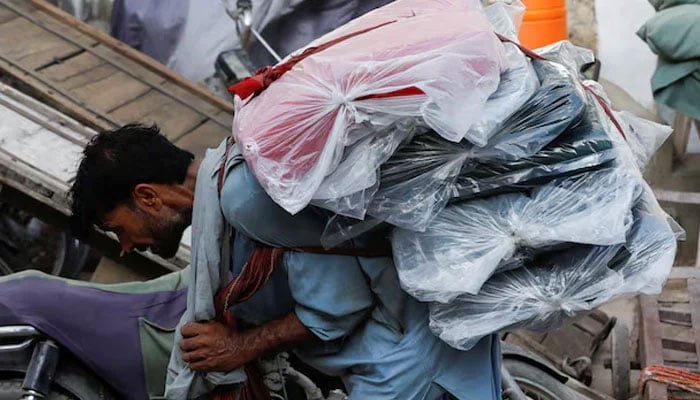
- Government domestic debt rose to Rs47.536 trillion in Q1FY25.
- External debt rose to Rs 22.034 trillion during the July-September period.
- The total external debt amounts to $133.4 billion, compared to $129.7 billion in September 2023.
KARACHI: Amid ongoing efforts by the incumbent government to improve economic indicators, the country’s debt-to-GDP ratio declined to 65.7%, recording its lowest level since June 2018. News reported on Tuesday.
According to Arif Habib Company Limited, the ratio of domestic debt to GDP reached 43.1%, while the ratio of external debt to GDP reached 22.7%.
Data released by the State Bank of Pakistan (SBP) show that the government’s debt saw a decline of 792 billion rupees or 1% month-on-month in September, confirming the government’s lower financing needs resulting from the budget surplus, a record high. Central bank profits and wise management of expenditures.
The total government debt stock fell to Rp69.57 trillion by the end of September 2024, down from Rp70.362 trillion at the end of August 2024.
However, the debt rose by Rs 656 billion in the first quarter of the current fiscal year. As of June 30, 2024, the debt stands at Rs 68.914 trillion.
The latest debt figures come amid ongoing talks between Pakistan and the International Monetary Fund with the latter’s team in Islamabad to assess the country’s progress in its $7 billion loan programme.
The primary agenda of the IMF team is to assess Pakistan’s external financing gap and measures being taken to address the shortfall in tax collection.
Moreover, State Bank of Pakistan data reveals that the government’s domestic debt rose to Rs47.536 trillion in the first quarter of FY25, up from Rs47.16 trillion at the end of the last fiscal year.
However, on a monthly basis, domestic debt declined and recorded Rp48.339 trillion at the end of August.
In addition, the government’s external debt rose to Rp22.034 trillion during July-September FY25, compared to Rp21.754 trillion at the end of June. At the end of August 2024, the external debt reached 22.023 trillion rupees.
“Government debt increased at its slowest pace in the first quarter since the first quarter of fiscal year 2022. This slowdown in debt growth is due to the government’s first fiscal surplus in 20 years, which was recorded in the first quarter of this fiscal year,” said AKD Research Director. Securities Limited Owais Ashraf.
“The government announced a record primary surplus of 3 trillion rupees and a fiscal surplus of 1.7 trillion rupees in the first quarter,” he added.
“This positive result was driven by the historic Rs 2.5 trillion dividend received from the State Bank of Pakistan and a significant 26% increase in tax revenues collected by the Federal Board of Revenue (FBR) coupled with prudent management on the expenditure front,” Ashraf noted.
Meanwhile, head of research at Ismail Iqbal Securities, Saad Hanif, sees central government debt rising from 62.3 trillion rupees in September 2023 to 69.6 trillion rupees in September 2024, with a focus on long-term debt.
“While domestic borrowing increased, the government favored longer-term debt, actively buying back Treasuries and extending short-term debt to longer maturities.
“External debt remained stable with slight increases, and the appreciation of the Pakistani rupee slightly mitigated its impact on the rupee. This shift towards longer-term debt could provide more stability and reduce refinancing risks, even though overall debt levels continue to rise,” he said.
Additionally, State Bank of Pakistan statistics show that Pakistan’s debt and liabilities increased to Rs85.836 trillion in the July-September period of FY25. This is up from Rs78.419 trillion during the same period last year.
In dollar terms, the country’s total external debt and obligations rose to $133.4 billion in the fiscal year from July to September 2025, compared to $131 billion at the end of June and $129.76 billion at the end of September 2023. The overall external debt reached $100.619 billion. As of September 30, 2024.
The central bank told analysts following last week’s monetary policy meeting that the overall debt stock has declined, and debt formation has improved. In addition, the maturities of these debts have also improved due to the increase in the share of multilateral debt.
The outstanding domestic debt situation also improved, as the share of short-term treasury bills decreased to 21 percent in four months of FY25, compared to 24 percent at the end of FY24. The authorities expect this share to decline to less than 20% by the end of FY20. 2025.
The reduction in interest rates, in accordance with the state budget plan, and the timely use of surplus funds for debt classification, are expected to significantly reduce the government’s debt servicing costs in fiscal year 2025.
The government’s total interest expenditures for fiscal year 2025 are now estimated at about 8.5 trillion rupees, compared to 9.8 trillion rupees expected in the current fiscal year’s budget. This reduction results in a total saving of 1.3 trillion rupees, or approximately 1.0% of GDP.
These savings will help control the fiscal deficit for FY25. SBP believes that the overall financing requirements are expected to be met. Of the total $26.1 billion in external payments for fiscal year 2025, the country must repay $6.3 billion in the remaining eight months of the current fiscal year.
